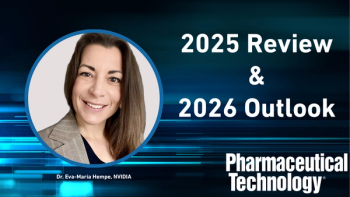
AI-Powered Digital Twins Achieve High Accuracy in Human Lung Function Forecasting
Key Takeaways
- Pharmaceutical R&D is hindered by high costs and low translatability of preclinical models, necessitating innovative approaches.
- Ex vivo lung perfusion (EVLP) provides a platform for testing therapies but faces challenges in standardizing drug evaluation.
At AAPS PharmSci 360, Xuanzi Zhou says digital twins accurately predict ex vivo lung function, revealing therapeutic effects missed by conventional preclinical drug testing.
The process of pharmaceutical R&D frequently encounters significant hurdles, including high costs and prolonged timelines, often stemming from the decreased translatability of findings from preclinical models, according to Xuanzi Zhou, PhD-student, University Health Network in Toronto, Canada, who presented a poster at
Ex vivo lung perfusion (EVLP) offers an advanced platform developed to assess isolated human lungs under physiological conditions, thereby enabling therapeutic testing for applications like stem cell therapy, gene therapy, and immunomodulation (1-6). Despite its utility, standardizing drug evaluation within EVLP using the conventional randomized two-arm study design presents challenges, say the researchers, specifically due to the limited availability of human organs, which prolongs enrollment and increases costs, and the substantial inter-subject variability, which complicates the interpretation of results.
To address these limitations, the team explored the emerging concept of digital twins—computer simulations of physical objects—an approach that is promising in medicine but largely unexplored in drug discovery (7). Given that EVLP procedures generate real-time, multi-modal data on lung function, according to Zhou, et al, this environment offers a unique opportunity to train machine learning (ML) models. The core objective of their study was the development of an ML-based methodology that uses more than 300 ML algorithms operating simultaneously to accurately simulate the future function of a human lung. As a demonstration of clinical utility, the researchers aimed to validate these digital twins for the preclinical evaluation of both the safety and efficacy of an EVLP-targeted therapy.
How were the digital lung models developed and trained?
The modeling effort was based on a comprehensive clinical dataset derived from EVLP clinical cases performed between 2008 and 2024 at the Toronto General Hospital. The resulting multi-modal data included a broad spectrum of human lung characteristics, such as physiological measurements, medical imaging features, transcriptomics, and various proteomic, metabolomic, and biochemical biomarkers.
To create the forecasting models, the investigators trained multi-modal models using k-fold cross-validation, employing a deep learning-based model known as a Gated Recurrent Unit alongside a tree-based XGBoost model. Model performance was quantitatively measured using mean absolute error and mean absolute percentage error.
Two distinct modeling strategies were deployed in developing the digital twins of the human lungs. The 'static' digital twin strategy used a single, static baseline dataset of lung function as input to forecast future function. In contrast, the 'dynamic' digital twin approach was designed to be recalibrated using additional functional data, forecasting only the immediate next time point based on the most recent lung function data.
For the proof-of-concept validation of these digital lungs, the researchers studied a cohort of 16 lungs that had previously received tissue-type plasminogen activator (tPA), a thrombolytic therapy. The therapeutic efficacy, quantified by pulmonary arterial pressure (PAP), and safety, assessed by edema levels, were evaluated on a personalized, case-by-case basis using the corresponding digital twin for each treated lung.
Did the digital twins reveal therapeutic effects missed by traditional methods?
The development was successful, resulting in a digital twin of an ex vivo human lung that accurately predicted lung function across more than 75 distinct functional parameters measured during EVLP. The digital twin approach demonstrated high reliability, achieving greater than 90% accuracy in both short- and long-term forecasting of physiology, biochemistry, metabolites, and transcriptomics (Figure).
The study team found that the digital twin approach for preclinical therapeutic evaluation outperformed conventional preclinical study designs. A key advantage is the ability of the digital twins to successfully predict the counterfactual outcome—the state of the lung if the therapy had not been applied. This capability enabled a paired statistical analysis between the corresponding treated lung and its untreated digital twin. As a representative example, one EVLP case treated with tPA displayed a reduction in PAP compared with its digital twin, without any significant increase in edema.
When performing paired analyses on the cohort of human lungs treated with tPA, the digital twin methodology revealed a significant reduction in PAP within two hours of treatment (P=0.031). This finding contrasts sharply with results from a conventional two-arm study design, which, when applied to the same cohort data, displayed no significant differences in PAP at either one or two hours post-treatment. Consequently, the study demonstrated that only the digital twin approach was sensitive enough to identify the preclinical treatment-induced reductions in PAP.
The digital twin approach resulted in a virtual model of human lungs built upon the world’s largest available dataset of clinical ex vivo lung perfusion procedures, state Zhou and team. These digital twins successfully and accurately predicted a comprehensive range of lung physiology parameters, in addition to proteomic, metabolomic, transcriptomic, and biochemical biomarkers. The models’ utility for preclinical therapeutic evaluation was validated using real-world data, demonstrating their capacity to reveal new insights into the effects of treatment. By facilitating direct comparisons between a physical human organ and its virtual counterpart, digital twins are poised to support advances in precision therapeutics and accelerate the process of preclinical drug discovery, concludes Zhou.
References
- Cypel, M; Yeung, J; Hirayama, S; et al.
Technique for Prolonged Normothermic Ex Vivo Lung Perfusion . J Heart Lung Transplant. 2008;27(12)1319-1325. - Cypel, M; Yeung, J; Liu, M; et al.
Normothermic ex vivo lung perfusion in clinical lung transplantation . N Engl J Med. 2011;364(15):1431-1440. - Mesaki, K; Juvet, S; Yeung, J; et al.
Immunomodulation of the Donor Lung with CRISPR-mediated Activation of IL-10 Expression . J Heart Lung Transplant. 2023;42(10):1363-1377. - Nakajima, D; Watanabe, Y; Ohsumi, A; et al.
Mesenchymal Stromal Cell Therapy During Ex Vivo Lung Perfusion Ameliorates Ischemia-reperfusion Injury in Lung Transplantation . J Heart Lung Transplant. 2019;38(11):1214-1223. - Wang, A; Ribeiro, R; Ali, A; et al.
Ex vivo Enzymatic Treatment Converts Blood Type A Donor Lungs into Universal Blood Type Lungs . Sci Transl Med. 2022;14(632):eabm7190. - Nykänen, A; Mariscal, A; Duong, A; et al.
Lung Transplant Immunomodulation with Genetically Engineered Mesenchymal Stromal Cells-Therapeutic Window for Interleukin-10 . Cells. 2024;13(10):859. - Zhou, X; Wang, B; Wei, Y; et al.
A Novel Approach to Preclinical Drug Development Using Digital Twins of Ex Vivo Human Lungs . AAPS PharmSci 360 2025 Poster Abstract. Accessed Nov 11, 2025.
Newsletter
Get the essential updates shaping the future of pharma manufacturing and compliance—subscribe today to Pharmaceutical Technology and never miss a breakthrough.




